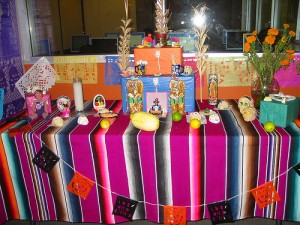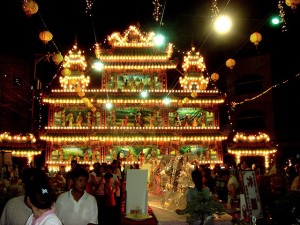
Americans mark autumn with two major holidays: Thanksgiving in late November, and Halloween on Oct. 31. The latter is a personal favorite: Ever since I watched It’s the Great Pumpkin, Charlie Brown! as a child, Halloween has been one of my anchor points for the fall season. Halloween as we know it, with the trick-or-treating and funny costumes, is for all intents and purposes a strictly Western practice. Though it has in recent years spread to South America, the Far East and Eastern Europe, some of these places have their own traditions which resemble our own Halloween.
Take for example our southern neighbor, Mexico, where Halloween is just the precursor to the two-day celebration of Día de los Muertos, or Day of the Dead. Halloween itself is celebrated very similarly to how we celebrate here in the U.S.: Kids may dress up and go around to houses, asking “¡Noche de Brujas, Halloween!” (“Witch’s Night, Halloween!”). Older generations may throw a Halloween-themed party which could include dressing in costume or “traditional” Halloween games. The two days after Halloween though, Nov. 1 and 2, play host to much more foreign, exciting and (in some ways) somber or serious forms of “celebration.” Día de los Muertos is meant to be an opportunity for people to honor their deceased loved ones or relations.
Millions of Mexicans will spend time during the year gathering the deceased’s favorite foods, drinks or possibly toys and games. Over the Día de los Muertos, they will lay these on their loved ones’ graves and pray for them. Tradition states that the items are there to encourage their loved ones’ spirits to return and hear the prayers for them. This holiday traces itself back to Mayan traditions of praying for ancestors, though it nicely intersects in subject matter with Halloween and the Catholic All Saints’ Day and All Souls’ Day.

In Europe, Halloween takes several different forms. Ireland and Great Britain are both similar to the United States — kids may dress up and go trick-or-treating, and parties are held with bobbing for apples and the like. You might come across a carved turnip instead of a carved pumpkin, though! Elsewhere in Europe you may find heavy Dracula themes in Romania (Transylvania) or Catholic traditions of All Saints Day in Greece. Overall, though, Europe is subject to a peculiar “re-adoption” of Halloween traditions from America, so you everything might be a bit too recognizable.
China, though, is where we can again find something similar yet different to our own celebrations. While it does not take place on Oct. 31, the Chinese Hungry Ghost Festival is similar to Halloween in some interesting ways. They both feature a preoccupation with the dead, and both involve numerous festivities and entertainment. The Hungry Ghost Festival is more similar to Día de los Muertos, though, in that the focus is on appeasing or communicating with the dead specifically. Chinese will set out food, burn money (today usually fake money) and pray earnestly to appease and gain protection from evil spirits. Some of the more well-known festivities include fantastical parades and the famous floating candle ceremonies, where candles are set to float on rivers in honor of the dead.

Many cultures in the world have almost exclusively integrated American Halloween customs into their own traditions; other cultures, like Australia, discourage Halloween celebrations for being so commercialized/American. No matter the case, the traditions exemplified by Mexico and some Gaelic countries, the integration of American traditions with the country’s own traditions and concepts, are fun and interesting to natives as well as travelers looking for a dash of their home celebrations and a healthy dose of foreign culture.

